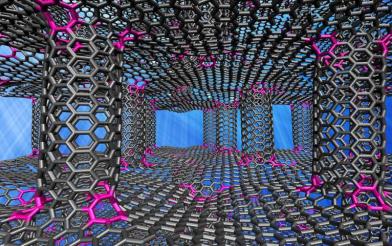Researchers at Rice University have built atom-level computer models of pillared grapheneâsheets of graphene connected by covalently bonded carbon nanotubesâand discovered that manipulating the joints between the nanotubes and graphene has a significant impact on the material's ability to direct heat. The team stated that this could prove important as electronic devices shrink and require more sophisticated heat sinks.

Researchers who study or are working to make pillared graphene have primarily viewed two characteristics of the theoretical material: the length of the pillars and their distance from each other. The new study suggests that a third parameterâthe nature of the junction between the graphene and nanotubesâshould also be considered.
However, that does not seem to be the optimal configuration for heat transport, according to the Rice team. It found that replacing six heptagons with three octagons would facilitate the turn while slightly stressing the graphene. That would wrinkle the graphene sheets' top and bottom while not significantly changing transport at the junctions.
The researchers intuitively expected the wrinkles to lower thermal transport and were surprised to find that thermal transport across the "in-plane" graphene became faster with wrinkles. They determined that having fewer rings in the junctions between nanotubes and graphene meant less scattering of heat-carrying phonons.
Measured along the longest plane, models with the octagons were nearly 20% better at transporting phonons than those without. The researchers thought phonon transport through the nanotubes, which they already knew was slower than in graphene, might be slower still under the influence of the octagons, but the altered interface didn't appear to have a significant effect.
"The reason lies in the geometry," the team said. "The lower the number of non-hexagonal rings in the junction (for example three octagons versus six heptagons), the lower the number of undesirable rings and thus lower phonon scattering and improved thermal transport". Because the junctions can adopt many different geometries depending on the radius and chirality of the nanotube, there are many more potential configurations to be modeled, they said.



